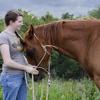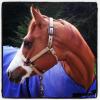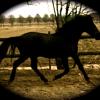To Define Dun
Forums
CMhorses wrote:I've had some
[quote=CMhorses]I've had some ideas about dun across the equine species. It seems like horses have one of the more minimal types, with also "countershading" being possible as a type and fjord dun looks to be different type as well. Fjord dun seems to super dilute but the striping is minimal. In normal dun it seems to have a fairly minimal dilution and striping. In donkeys,it seems to vary between very minimal dilution and striping to moderate dilution with about horse level stripes. Zebras have extreme concentration and extreme dilution, but in hyrbrids they have moderate to mild dilution and striping, seems to me that in zebras at least, their level of dilution/striping is H/Z, but who knows :rofl .[/quote]
What about tabby cats? I would consider them being dun too...? I always thought those are primitive markings useful for camouflage in those species mentioned above.
If the sun shines in the right angle, you can see the striping even in black cats, reminds me of countershading/sooty in bay horses.
I would attribute the different Fjord-dun to pangare co-acting with dun. Maybe there is - just like with pangare in Fjords - one modifier present in each of those other "duns" as well??? :-?
Oh I love that site thanks, I
Oh I love that site thanks, I think I have looked at it before a couple years ago.
I was riding with a friend this weekend who has a bay TB and I noticed he had a somewhat defined dorsal stripe, but he is just normal bay color so I figured it must just be countershading?
Quote:What about tabby cats?
[quote]What about tabby cats? I would consider them being dun too...? I always thought those are primitive markings useful for camouflage in those species mentioned above.
If the sun shines in the right angle, you can see the striping even in black cats, reminds me of countershading/sooty in bay horses.[/quote]
Tabby in cats is regulated by Agouti but IMO the stripes are present in all cats even the self colored (solid) ones. This is apparent in orange cats who are always striped even if they are aa (self) at agouti.
CMhorses wrote:I'm pretty
[quote=CMhorses]I'm pretty sure pangare isnt what is responsible for the extreme dilution in fjords. You don't see that kind of extreme dilution in donkeys or in Przewalski's.[/quote]
But you can see that dilution of chestnut due to pangare in Haflingers as well:
http://www.haflinger-online.de/Bussmann…
http://www.oesters-pferde.de/de/bildarc…
http://www.equigaia.de/upload/images/o2…
https://www.fotocent.de/imgp/2b5f2b55a6…
http://fotowagner.info/slides/Haflinger…
I think pangare has a factor.
I think pangare has a factor. It also helps further dilute champagne in American Cream Drafts so they appear champagne + cream without actually possessing cream. Also donkey pangare is a completely different mutation from the one in horses that can affect both red and [u]black[/u] pigment. Horse pangare only dilutes red.
Donkeys and Przewalski's are also a different species from modern domestic horses, different chromosome counts and all, so they aren't as 1 to 1 comparable as we often like to think.
The marker test for dun detects it in fjords and stock horses, so they do have the same mutation of dun. Don't forget selective breeding causing certain traits and modifiers to be inherited to cause a more diluted looking version of dun versus a darker one. Fjord zorses have almost no stripes so those are dominant genes they have inherited to be lighter. http://www.lifeinthefastlane.ca/wp-cont…
I'm personally of the belief that dun has at least one other mutation in domestic horses. Specifically in Iberian horses. The test doesn't seem to work in them since obvious dun horses have tested negative, while solid black horses have tested positive. We need a direct test.
Non duns testing dun: http://colorgenetics.info/equine/forum/…
Obvious dun phenotyped Iberian horse, named Afortunado, who tested negative: http://www.hippo-logistics.com/newdilut…





I've had some ideas about dun
I've had some ideas about dun across the equine species. It seems like horses have one of the more minimal types, with also "countershading" being possible as a type and fjord dun looks to be different type as well. Fjord dun seems to super dilute but the striping is minimal. In normal dun it seems to have a fairly minimal dilution and striping. In donkeys,it seems to vary between very minimal dilution and striping to moderate dilution with about horse level stripes. Zebras have extreme concentration and extreme dilution, but in hyrbrids they have moderate to mild dilution and striping, seems to me that in zebras at least, their level of dilution/striping is H/Z, but who knows :rofl .